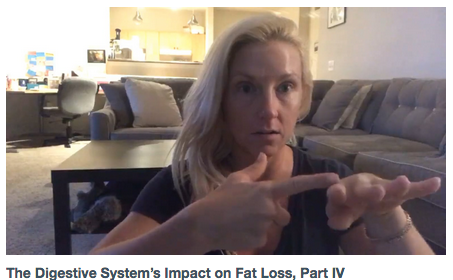When you diet and exercise and still have a hard time losing body fat, you have to dig deeper as to why. Eating clean food is great, as is doing HIIT workouts and strength training, but you don’t stand a chance if your digestive system is not functioning properly. Find out why in this video..
[video_player type=”embed” style=”1″ dimensions=”560×315″ width=”560″ height=”315″ align=”center” margin_top=”0″ margin_bottom=”20″ ipad_color=”black”]![]() [/video_player]
[/video_player]
First, to find out the role of the digestive system as a whole, check out Part I of this three part series here.
Then check out Part II here.
And Part III here.
The organs of the lower GI tract –
1. The small intestine. This is where most of our nutrition is absorbed. The small intestine is lined with finger-like structures called the gut mucosa. This makes it possible for the good nutrition to go into your blood from here and beyond the finger-like structures are a wall of tightly lined cells that keep the bad stuff from getting in. However if the gut mucosa or the cell wall becomes damaged or inflamed, it cannot protect your body correctly. Stress, certain foods, medication, aging and environmental toxins can compromise this wall.
Because this is where nutrition is absorbed, if we have food sensitivities, inflammation and immune response happen here. If the cell wall is damaged and food comes in direct contact with our immune system cells, our immune system can make antibodies against the food we are eating, which is the cause of auto-immune dysfunction, like Celiac disease.
2. The large intestine. This is where remaining food particles come into contact with good bacteria and the bacteria breaks down food even further into nutrients we can use. The bacteria also recycles used hormones, bile acid, ammonia and short chain fatty acids. The bacteria in the large intestine is affected by the foods we eat, medications and our hydration. The large intestine needs to be “exercised” so the walls don’t become lax and we end up with diverticulitis, so eat lots of fiber to keep the lower intestine healthy.
3. The appendix. Primarily, the appendix is used when we are little to help our immune system mature, so it’s not a super important organ to us as adults. But to keep it healthy, don’t eat a lot of sugar and eat plenty of fiber.
4. The colon. The colon absorbs water and remaining nutrients that have left the large intestine. If we cannot stay hydrated because of diarrhea or are not hydrated enough, this can make us constipated.
5. The rectum. The rectum collects stool in our body until there is enough for a bowel movement. From the moment we swallow, everything that happens in the GI tract is involuntary until the bowel movement, which is kinda crazy to think about. But, because pooping is a voluntary act, we need to listen when we have the urge, because if we don’t listen it could cause us to get constipated. Also, it is “normal” and healthy to poop one to three times a day so eat clean food!
Do you need help figuring out the right clean eating meal plan for you?
Go to Commit2FitCoaching.com/freeassessment and let me help you.
Your Coach,
Kyra
P.S. Everyone is different. Some people need more carbs, more food, different workouts from others. It’s all individualized which is why I run #Commit2Fit with personalized clean eating meal plans and workout plans. Everything should be custom and designed specifically for YOU.
